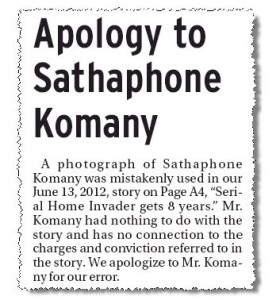Clients often ask us what the protocols are for the printing / airing of corrections in cases in which a journalist gets it wrong.
The truth is that there is no protocol and you’ll have to persist and insist that the media outlet gives you the correction you are due. And NO the correction, if you get it, will not be as prominent as the original mistake.
Check out this booboo below from Canadian publication The Province.
It clearly misidentifies a man (in reality Sathaphone Komany) and his dog as serial home invaders but the scale of the apology in no way counterbalances the size of the error.
Tips for gaining a correction:
1. Don’t wait: journalists are busy and your issue will feel less and less significant with each new story they file.
2. Don’t panic: it may be tempting to threaten legal action or “deregistration”. Don’t. be strong and clear, not aggressive.
3. Gather your facts: the colder and harder the better.
4. Gather your troops: Communicate to your stakeholders via website, eNewsletter and social media. In certyain cases you may ask them to make their feeling known to recalcitrant media. Media will never tell you this but they DO pay attention when something they say receives a deluge of feedback. Some groups out there in the community are well known within media circles as creating a headache over the slightest error. This creates self-censorship and double-checking.
5. Go higher up the food chain, if all else fails.
6. Prepare for disapointment as the chances of receiving an apology is slim.
7. Approach the Australian Press Council if all else fails. Remember though – its resources are scarce and sanctions limited.
Note: a correction is just that – a correction to a factual error; not disatisfaction with the tone of an article or the selection of quote.


